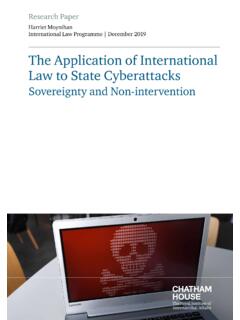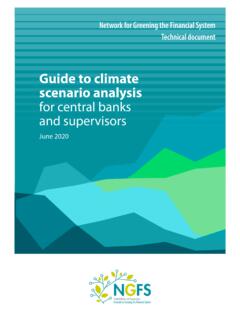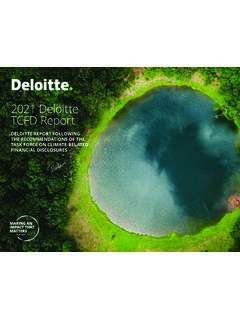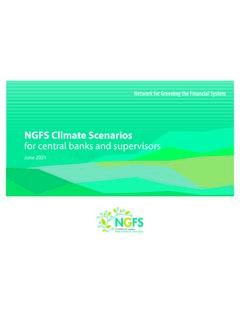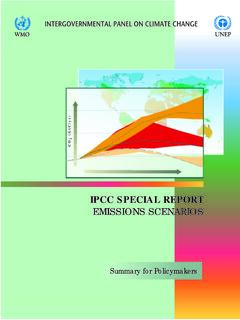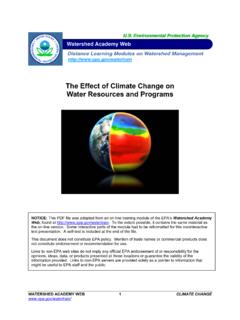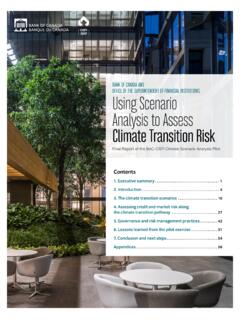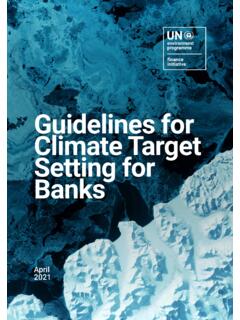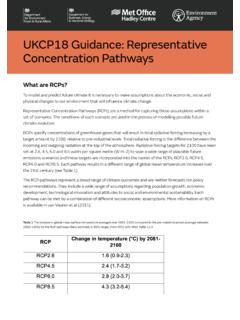Transcription of Climate change risk Research assessment 2021
1 Research Climate change risk Paper assessment 2021. Environment and Society Programme The risks are compounding, September 2021 and without immediate action the impacts will be devastating Daniel Quiggin, Kris De Meyer, Lucy Hubble-Rose and Antony Froggatt Chatham House, the Royal Institute of International Affairs, is a world-leading policy institute based in London. Our mission is to help governments and societies build a sustainably secure, prosperous and just world. Contents Summary 2. 01 Introduction 4. 02 Emissions trajectory and risks 6. 03 Direct Climate impacts 9. 04 Cascading systemic risks 35. 05 Conclusions 46. About the authors 48. Acknowledgments 49. 1 Chatham House Summary If policy ambition, low-carbon technology deployment and investment follow current trends, C of warming by the end of this century is likely, relative to pre-industrial temperatures.
2 A plausible worst case of C is possible (10 per cent chance). These projections assume Paris Agreement signatories meet their NDCs. If they fail to do so, the probability of extreme temperature increases is non-negligible. Any relapse or stasis in emissions reduction policies could lead to a plausible worst case of 7 C of warming by the end of the century (10 per cent chance). If emissions follow the trajectory set by current NDCs, there is a less than 5 per cent chance of keeping temperatures well below 2 C relative to pre-industrial levels, and less than 1 per cent chance of reaching the C Paris Agreement target. There is currently a focus on net zero pledges, and an implicit assumption these targets will avert Climate change . However, net zero pledges lack policy detail and delivery mechanisms, and the deficit between targets and the global carbon budget is widening every year.
3 Unless NDCs are dramatically increased, and policy and delivery mechanisms are commensurately revised, many of the impacts described in this Research paper are likely to be locked in by 2040 and become so severe they go beyond the limits of what nations can adapt to. The governments of highly emitting countries have an opportunity to accelerate emissions reductions through ambitious revisions of their NDCs, significantly enhancing policy delivery mechanisms, and incentivizing rapid large-scale investment in low-carbon technologies. This will lead to cheaper energy and avert the worst Climate impacts. If emissions do not come down drastically before 2030, then by 2040 some billion people are likely to experience major heatwaves, 12 times more than the historic average. By the 2030s, 400 million people globally each year are likely to be exposed to temperatures exceeding the workability threshold.
4 Also by the 2030s, the number of people on the planet exposed to heat stress exceeding the survivability threshold is likely to surpass 10 million a year. To meet global demand, agriculture will need to produce almost 50 per cent more food by 2050. However, yields could decline by 30 per cent in the absence of dramatic emissions reductions. By 2040, the average proportion of global cropland affected by severe drought will likely rise to 32 per cent a year, more than three times the historic average. 2 Chatham House Climate change risk assessment 2021. The risks are compounding, and without immediate action the impacts will be devastating By the 2040s, the probability of a 10 per cent yield loss, or greater, within the top four maize producing countries (the US, China, Brazil and Argentina) rises to between 40 and 70 per cent.
5 These countries currently account for 87 per cent of the world's maize exports. The probability of a synchronous, greater than 10 per cent crop failure across all four countries during the 2040s is just less than 50 per cent. Globally, on average, wheat and rice together account for 37 per cent of people's calorific intake. The central 2050 estimate indicates that more than 35 per cent of the global cropland used to grow both these critical crops could be subject to damaging hot spells. But this vulnerability could exceed 40 per cent in a plausible worst-case scenario. The central estimate for 2050 also indicates these same global cropland areas will be impacted by reductions in crop duration periods of at least 10 days, exceeding 60 per cent for winter wheat, 40 per cent for spring wheat, and 30 per cent for rice.
6 By 2040, almost 700 million people a year are likely to be exposed to droughts of at least six months' duration, nearly double the global historic annual average. No region will be spared, but by 2040 East and South Asia will be most impacted . with, respectively, 125 million and 105 million people likely to experience prolonged drought. Across Africa, 152 million people each year are likely to be impacted. Cascading Climate impacts can be expected to cause higher mortality rates, drive political instability and greater national insecurity, and fuel regional and international conflict. During an expert elicitation exercise conducted as part of the Research for this paper, the cascading risks that participants identified greatest concern over were the interconnections between shifting weather patterns, resulting in changes to ecosystems and the rise of pests and diseases.
7 Combined with heatwaves and drought, these impacts will likely drive unprecedented crop failure, food insecurity and migration. In turn, all will likely result in increased infectious diseases, and a negative feedback loop compounding each impact. 3 Chatham House 01. Introduction Climate risks are increasing. Many of the impacts described in this Research paper will be locked in by 2040, and become so severe they go beyond the limits of what many nations can adapt to. In preparation for the UN Climate change Conference (COP26), to be held in Glasgow in November 2021, signatories to the 2015 Paris Agreement on Climate change are for the first time revising their Climate mitigation plans, or nationally determined contributions (NDCs). The Paris Agreement set the common goal of limiting global average temperature increases (relative to pre-industrial levels).
8 To well below' 2 C and pursuing efforts' to C; and envisaged a five-year revision process to NDCs to encourage increasingly ambitious national pledges. However, the commitments made in line with current NDCs fall far short of limiting global temperature increases to 2 C above pre-industrial levels, let alone C. By 2030, under current policies, the gap in annual emissions compared with a 2 C least-cost pathway will have reached 14 GtCO , equivalent to nearly half of current energy sector This Research paper highlights the risks and likely impacts if the goals set under the Paris Agreement are not met, and the world follows an emissions pathway consistent with recent historical trends. Simply updating without significantly enhancing . NDCs will not guarantee the Paris Agreement goals are met; nor will enhanced pledges without swift and decisive delivery of those pledges.
9 The governments of highly emitting countries have an opportunity to accelerate emissions reductions through ambitious revisions of their NDCs, significantly enhancing policy delivery mechanisms, and incentivizing rapid large-scale investment in low-carbon technologies. This will lead to cheaper energy and avert the worst Climate impacts. The COVID-19 pandemic has underscored the interconnections and interdependences between nations, as well as the potential for cascading sectoral impacts with far-reaching consequences for society. This shows, too, the critical 1 Committee on Climate change and China Expert Panel on Climate change (2018), UK-China Cooperation on Climate change Risk assessment : Developing Indicators of Climate Risk, indicators-of- Climate -risk-china-uk (accessed 13 Aug. 2021). 4 Chatham House Climate change risk assessment 2021.
10 The risks are compounding, and without immediate action the impacts will be devastating need to consider whether existing systems are sufficiently resilient, not only to domestic sectoral shocks but to global adverse trends and events. Climate change is among the greatest such risks. Risk assessments are a critical tool in enabling decision-makers to allocate appropriate resources, within finite budgets, to the various challenges society faces. Climate change risks are increasing over time, and what might be a small risk in the near term could embody overwhelming impacts in the medium to long term. Risks can be defined by a probability of occurrence and severity of impact;. Climate risks are no different. This paper presents high-probability, high-impact Climate risks as well as low-probability, high-impact Climate risks, recognizing that a low-probability outcome may still correspond to a high risk if the impact is severe.






